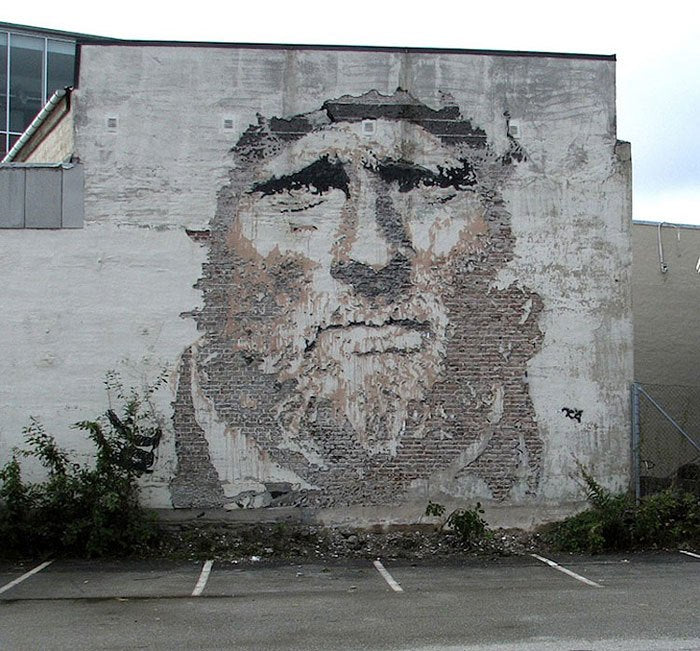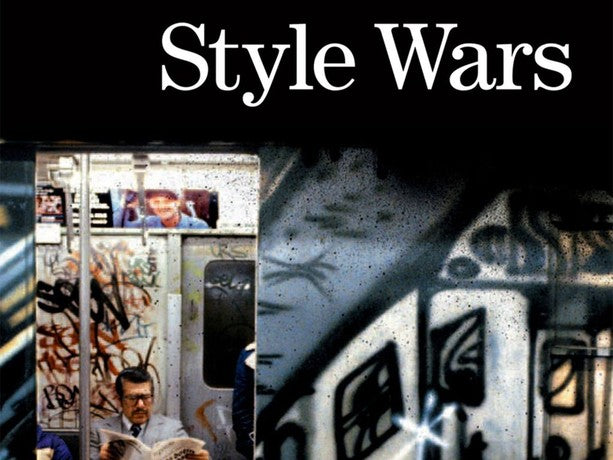However you care to label him, Portuguese street art sensation Alexandre Farto and his utterly unique mural art defy strict categorization. Though Farto is known most famously by the moniker Vhils (pronounced “veels” and made up of his favorite combination of fast-scribbled letters), critics have also given him such varied titles as “global ambassador for Portuguese street art,” “sculptor,” “experimenter,” “urban archeologist” and “messenger.” Indeed, Vhils’ message is one he conveys not only in the work itself, but also in the very act of its creation.

Using stencils, chisels, drills, and, sometimes, even explosives, Vhils carves away hunks of buildings, doors, layered advertising posters, and countless other elements of the urban landscape in a groundbreaking take on the ancient art of relief sculpture. Combining classic technique with a fresh, edgy perspective, Vhils crafts anonymous portraits of everyday citizens, exploring in his subjects and through his creative-destructive methods themes of transformation, loss, decay, and impermanence.

Scroll through Vhils’ photo gallery and you’re sure to be struck by the haunting images he’s left in a city’s stone, wood, and metal: faces unglamorous and unsmiling, at once ordinary and iconic, with eyes weary, lost, or longing, staring back at you or, more often, into the distance, as if in search of something. Look closely and you may have the eerie sense that to see Vhils art is to see not just ordinary faces carved into a city’s walls, but truths uncovered – spirits that had been hidden beneath the rust and grime all along, waiting to be revealed.

“Beneath the Surface”: Vhils’ Early Inspiration & Mural Art Breakthrough
Born in Lisbon in 1987, Vhils came of age in a time of great social and political change. Just over a decade earlier, a military coup had overthrown the fascist dictatorship that had ruled Portugal since the early 1930’s, and as a boy Vhils was surrounded by the billboards and graffiti that had gone up over the crumbling political murals of the post-coup period.
Though Vhils had been involved in graffiti art since the age of 10, tagging, train-bombing, and experimenting with stencils, stickers, and paste-up, these layers of posters were what ultimately inspired his trademark mural art technique. Seeing how “the city [had grown] fat with these layers,” Vhils told The Atlantic,he considered the peeling murals and how his own work “could use the layers of the past to reflect the city, to show people living in it and how their identity was lost, or forgotten.”

Fascinated with what he called, in an interview with Portugal's Aujourd'hui, the “random visual dialogue [these murals] established with subsequent layers of advertising and graffiti,” Vhils began to paint walls and billboards white and to carve away negative space, at once creating something new and unearthing bits of the city long-buried. As Vhils told Designboom: “I felt that by destroying I was revealing.”
A wider audience began to learn about Vhils’ art in 2008, when he created one such portrait next to an image by street art icon Banksy in the Leake Street Tunnel at London’s Cans Festival. Vhils’ mural – which depicted an old woman and her younger counterpart, the two mirrored, facing opposite directions – was particularly poignant next to Banksy’s irreverent image of a man power-washing a set of ancient cave drawings (his idea of “graffiti”) from the tunnel wall. The British daily paper The Timesran a photo of Vhils’ piece on its front page, and the mural artist was on his way to mainstream recognition.
Led by “what lies beneath the surface of each material,” Vhils has since gone on to become the youngest artist to be signed by Banksy’s agent, Steve Lazarides, to show his work in the UK, France, China, Australia, and beyond, and to collaborate with other artists and musicians, including the world-famous rock band U2, whose striking music video “Raised By Wolves” he directed, contributing some explosive mural art.

“The Impermanence of Matter”: What We See When We See Vhils Art
A key element of Vhils’ artistic process is his unflinching commitment to spontaneity and constant discovery in his work. Vhils has stated that though he starts with an idea of what he is trying to create, ultimately, as he told Wiredmagazine: “I never have and never want to have absolute control over what I’m doing – I like the unexpected and the uncertain. I am interested in working with what one can’t control and exploring the impermanence of matter.”
Vhils’ obsession with this theme of transience may also be the source of his innovative technique and prolific nature. The artist told Aujourd’huihe “grew up with this feeling that one day [he] wouldn’t be able to do more or create more,” a feeling he attributes to his stifled childhood creativity or to an irrational fear of death. This, he speculates, may be the reason his work is now “gushing out in a torrent,” driven by his desire to make sense of the ephemeral nature of cities, societies, his own art, and the world itself. “Perhaps the day I eventually manage to understand,” he said, “is the day I stop creating.”

New works by Vhils demonstrate his continued interest “not only in highlighting this ephemeral condition, but also in instigating it.” This philosophy not only animates Vhils’ work but is also at the heart of his relationship to it. “When I work I become one of those layers I’m talking about,” Vhils told Alex Hoyt in The Atlantic.“The possibility that someone might cover my art—it’s just part of the process...I don’t have any problem with that. While I’m alive, I’ll try to do more.”

Urban Fragments: New Works by Vhils
If you find yourself in Paris this spring and early summer (2018), you have an opportunity to see Vhils art at a pair of unique gallery openings: “Fragments Urbains” at Le Centquatre-Paris and “Décombres” at Galerie Magda Danysz. These solo shows, both of which opened this weekend, feature new works by Vhils that, in his own words, “carve into,” the nature of contemporary urban societies, “dissect them,” and “bring to the surface something that speaks of our essence, our viscera as human beings living in these large global cities of the 21st century.”

The exhibit at Le Centquatre features new works by Vhils described by the gallery as “discrete and striking, often gigantic.” The show includes Vhils’ work with such new forms as video installation, as well as those more familiar, like Styrofoam sculptures, etched wooden doors and carved layered posters. The exhibit’s 30 or so pieces are spread across a series of rooms, each showcasing a different technique, such that visitors are able to move through each room and immerse themselves in one medium at a time as they take in pieces made with wood, carved posters, acid painting, and engraved metal.

A few kilometers away, at the Galerie Magda Danysz, Vhils has created a “project room” that complements the Le Centquatre exhibit, offering visitors another opportunity to learn about Vhils’ art and how it’s made. Here you’ll find some of the artist’s tools as well a series of new works by Vhils in cement, “acid-etched metal plates, carved wooden doors and billboards.” The Galerie Magda Danysz website features a Vhils photo gallery where you can preview such pieces, including a series of unbodied cast cement sculpture eyes, a rare smiling face formed of countless carved advertising poster scraps, and the negative image of a grizzled face dug into an old wooden door.
The new works by Vhils on display at these Paris gallery openings are a testament to the artist’s ability to adapt, grow, and continually investigate new forms and methods, never settling for just the safe or familiar. It seems that Vhils views his art, like the city itself, as “a living organism that evolves by means of creation and destruction.”
“Fragments Urbains” at Le Centquatre and “Décombres” at Galerie Magda Danysz both run through July 29, 2018 in Paris.






Leave a comment (all fields required)